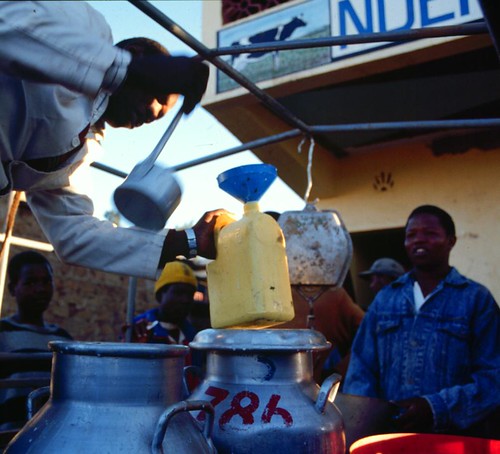Collecting milk in Kenya’s informal market (photo credit: ILRI/Dave Elsworth).
Do estimates of the agricultural gross domestic product (GDP) of African nations really underestimate the value of the contribution from the livestock sector, as livestock specialists at the International Livestock Research Institute (ILRI) and elsewhere frequently complain? In Kenya and Ethiopia, the answer is a resounding ‘Yes’.
A new study by the Inter-Governmental Authority on Development (IGAD) Livestock Policy Initiative (LPI), which worked with national partners, concludes that livestock’s contribution to Kenya’s agricultural GDP is a whopping two and a half times larger than the official estimate for 2009. An earlier IGAD study concluded that livestock’s contribution to Ethiopia’s agricultural GDP has been even more dramatically under-reported; livestock’s contribution is now being estimated at three and a half times larger than that of the last official estimate available.
In Kenya, ‘This increase of 150% over official estimates means that the livestock contribution to agricultural GDP is only slightly less than that from arable agriculture, i.e. 320 billion Kenyan shillings for livestock (about $4.21 billion US dollars in 2009) versus 399 billion Kenyan shillings for crops and horticulture (in 2009 roughly $5.25 billion US dollars). . . .
‘According to the revised estimates, milk is Kenya’s most economically important livestock product, providing a little less than three quarters of the total gross value of livestock’s contribution to the agricultural sector. In terms of its contribution to agricultural GDP, milk is about four times more important than meat.
‘Cattle are Kenya’s most important source of red meat, supplying by value about 80% of the nation’s ruminant offtake for slaughter. More than 80% of the beef consumed in Kenya is produced by pastoralists, either domestically or in neighbouring countries and then imported on the hoof, often unofficially.’
In addition, the broad range of benefits rural food producers derive from livestock keeping—including manure for fertilizing crop field, traction for pulling ploughs, and serving as a means of savings and credit and insurance—represent about 11% of the value of the livestock contribution to GDP in Kenya and more than 50% in Ethiopia.
‘The conclusion to be drawn from this study is that Kenya’s livestock are economically much more important than hitherto believed; in fact, only marginally less than crops and horticulture combined. Agriculture and forestry are by far Kenya’s most important economic sector in terms of domestic production and it would now appear that livestock provide about 43% of the output from this sector. . . .’
We link here to the whole policy brief from the Inter-Governmental Authority on Development (IGAD) Livestock Policy Initiative (LPI – IGAD LPI website). The brief was based on working paper by the United Nations Food and Agriculture Organization and IGAD: The Contribution of Livestock to the Kenyan Economy, No. 03-2011, by Roy Behnke and David Muthami.
Read Part 1 and Part 2 of the earlier IGAD LPI working papers on Ethiopia (also a policy brief).

